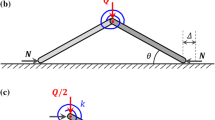Abstract
The pre-critical, critical, and post-critical nonlinear response of an imperfect due to loading eccentricity two-bar frame is thoroughly discussed. In seeking the maximum load-carrying capacity of this non-sway frame, it was qualitatively established that its loss of stability occurs through a limit point and hence, the case of an asymmetric bifurcation can be considered only in an asymptotic sense. After deriving the nonlinear equilibrium equations with unknowns for the two bar axial forces, we can consider such a continuous system as a two-degree-of-freedom model with generalized coordinates the above axial forces. Then, the equilibrium equations and the stability determinant of the frame can be determined in terms of the first and second derivatives of its total potential energy (TPE) with respect to the axial forces. The vanishing of the second variation of the TPE together with the equilibrium equations allows a simple and direct evaluation of the buckling load. Numerical examples demonstrate the efficiency and the reliability of the proposed method.
Similar content being viewed by others
References
Koiter, W.T.: On the stability of elastic equilibrium. PhD thesis presented to the Polytechnic Institute of Delft, The Netherlands, 1945; English translation: NASA TT-F-10833, 1967
Thompson, J.M.T.; Hunt, G.W.: A General Theory of Elastic Stability. London: Wiley 1973
Ioannidis, G.I.; Raftoyiannis, I.G.; Kounadis, A.N.: Nonlinear buckling of imperfect systems with symmetric imperfections. Arch Appl Mech 73 (2004) 711–717
Brush, D.O.; Almroth, B.O.: Buckling of Bars, Plates, and Shells. New York: McGraw-Hill, 1975
Kounadis, A.N.: Dynamic buckling of simple two-bar frames using catastrophe theory. Int J Nonlinear Mech 37 (2002) 1249–1259
Kounadis, A.N.; Ioannidis, G.; Lignos, X.: Stability analysis of a two-bar frame using catastrophe theory. In: Proceedings Eurosteel ‘02, Coimbra 1 (2002) 149–161
Simitses, G.A.: Elastic stability of structures. Englewood Cliffs: Prentice Hall, 1976
Kounadis, A.N.; Giri, J.; Simitses, G.A.: Nonlinear stability analysis of an eccentrically loaded two-bar frame. J Appl Mech ASME 44(4), (1977) 701–716
Simitses, G.A.; Kounadis, A.N.: Buckling of imperfect rigid-jointed frames. J Eng Mech Div ASCE 104(EM3), (1978) 569–586
Kounadis, A.N.: An efficient simplified approach for the nonlinear buckling analysis of frames. AIAA J 23(8), (1985) 1254–1259
Kounadis, A.N.: Efficiency and accuracy of linearized postbuckling analyses of frames based on elastica. Int J Solids Struct 24(11), (1988) 1097–1112
Timoshenko, S.P.; Gere, J.M.: Theory of Elastic Stability. New York: McGraw-Hill, 1961
Wolfram, S.: Mathematica, 4th edn., version 4. London: Cambridge University Press, 1999
Ioannidis, G.I.; Raftoyiannis I.G.: A simplified nonlinear stability analysis of an imperfect rectangular two-bar frame. Comput Mech 35 (2005) 127–133
Author information
Authors and Affiliations
Corresponding author
Additional information
The authors are indebted to the National Technical University of Athens for the financial support of the project “Thalis Grant”, whose partial results are reported in this paper.
Rights and permissions
About this article
Cite this article
Ioannidis, G., Raftoyiannis, I. & Kounadis, A. A method for the direct evaluation of buckling loads of an imperfect two-bar frame. Arch Appl Mech 74, 299–308 (2005). https://doi.org/10.1007/s00419-004-0352-7
Received:
Accepted:
Issue Date:
DOI: https://doi.org/10.1007/s00419-004-0352-7




